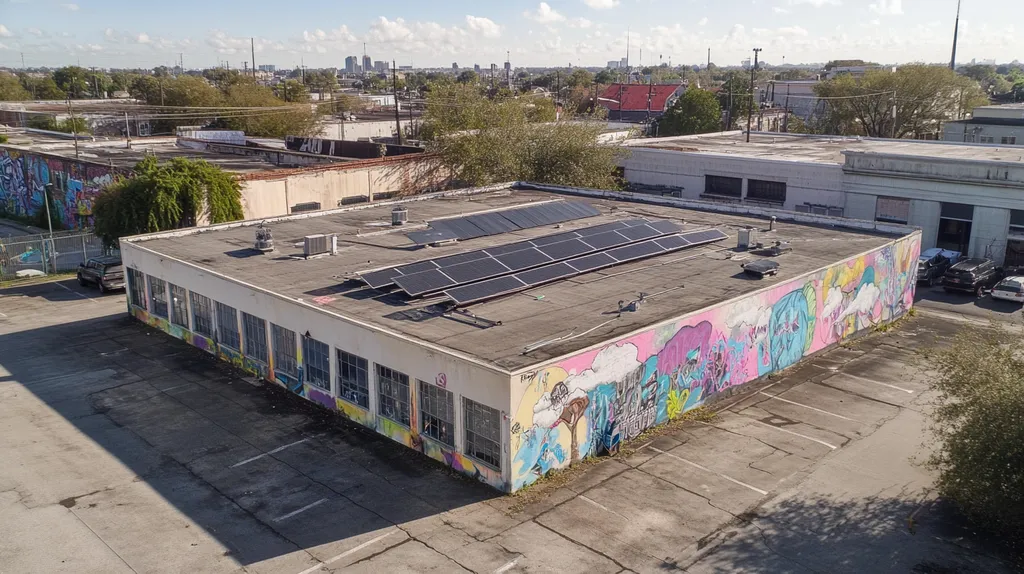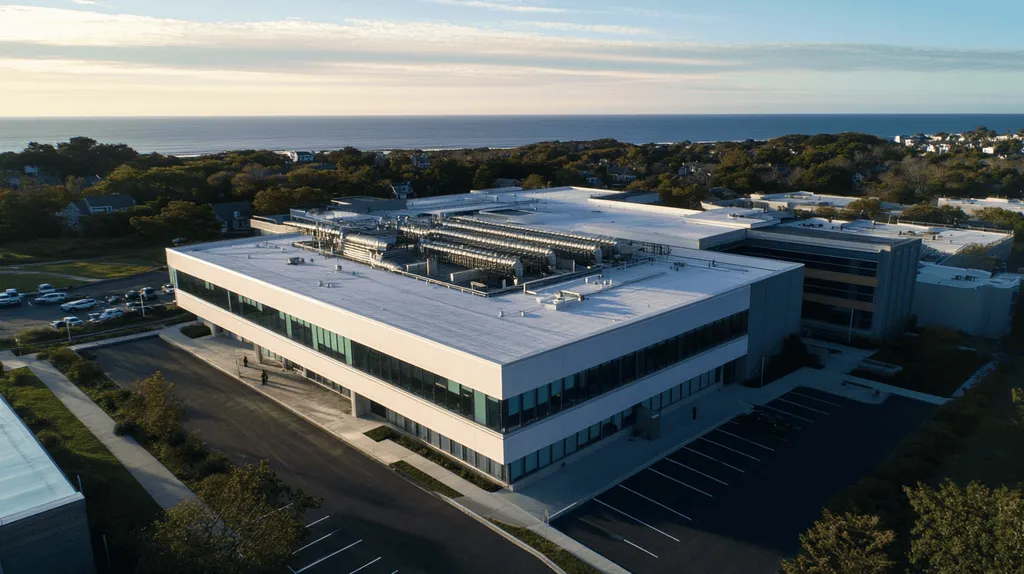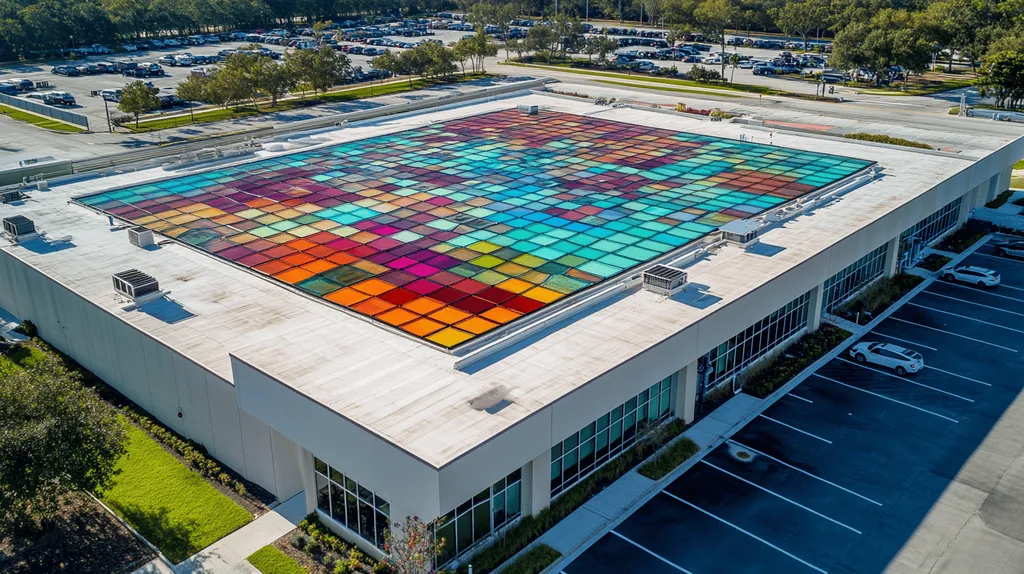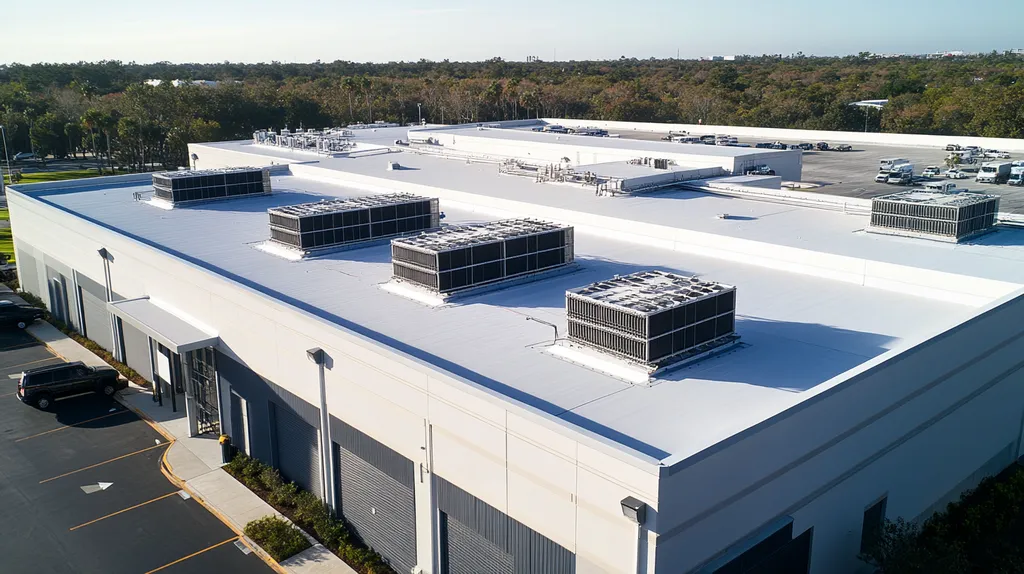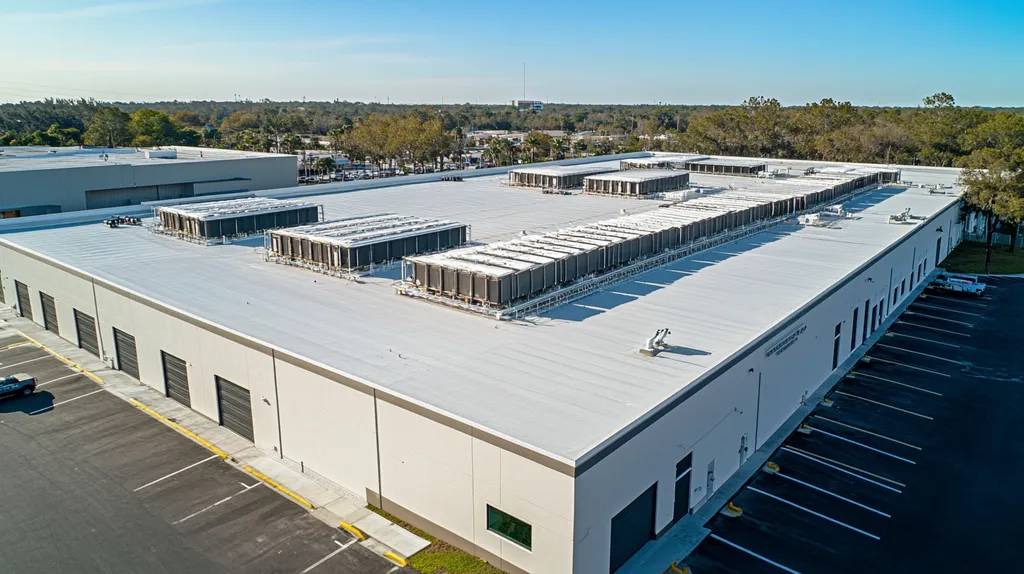In today’s commercial buildings, poor air quality costs businesses an estimated $15 billion annually in lost productivity and increased health care expenses. Much of this stems from inadequate roofing systems that fail to manage airflow, moisture, and pollutants effectively.
As building codes evolve and awareness of indoor air quality grows, the relationship between roofing systems and occupant health has moved to the forefront of facility management concerns.
This comprehensive guide examines how commercial roofing choices impact indoor air quality, from material selection and ventilation design to maintenance protocols that protect both building assets and occupant wellbeing.
SECTION 1: FUNDAMENTAL CONCEPTS
The role of roofing in indoor air quality is not just a technical detail; it’s a critical concern for commercial property owners and facility managers. Poor air quality has been shown to correlate with serious health problems, including respiratory diseases and diminished productivity. Alarmingly, research reveals that subpar indoor air quality can lead to productivity losses of up to 8%. This section will delve into how roofing systems influence air quality, the essential role of ventilation, and fundamental moisture management principles.
Impact of Roofing on Indoor Air Quality
The roofing system serves as a key player in shaping a commercial building’s internal environment. Choosing the right insulation and materials can significantly minimize the accumulation of harmful airborne pollutants. In contrast, inadequate roofing can trap toxins and moisture, leading to deteriorating air quality.
For example, roofs made from toxic materials can release detrimental substances into the building. This leaching can occur during installation or over time as the roof ages and becomes more permeable. Without sufficient safeguards, indoor air quality can plummet, putting occupants’ health at risk.
In addition, the type of roofing materials selected can influence volatile organic compound (VOC) levels inside a building. These VOCs, which are emitted from various building materials, can adversely affect health. Using low-emission roofing materials is essential for reducing indoor air pollution.
Ultimately, a roofing system should be meticulously designed and constructed using materials that specifically promote optimal indoor air quality.
Role of Ventilation in Air Quality
Ventilation is vital for maintaining healthy indoor air quality in commercial spaces. Adequate ventilation systems are necessary to remove stale air and replace it with fresh air, diluting indoor pollutants and safeguarding occupant health.
A lack of sufficient ventilation can lead to “sick building syndrome,” where occupants experience discomforting health issues like headaches and throat irritation. Insufficient indoor air circulation exacerbates these problems, underscoring the importance of effective ventilation strategies.
Moreover, the type of ventilation system significantly impacts air quality. While natural ventilation, such as operable windows, is favorable, it’s not always realistic for larger buildings. Mechanical systems are often essential to ensure a consistent flow of air, particularly in densely populated facilities.
Proper ventilation systems should work seamlessly with the roofing structure. For instance, roof vents allow heat to escape while enabling air circulation at lower levels. This synergy between roofing and ventilation is crucial for effective air quality management.
Basic Principles of Moisture Management
Moisture management is a fundamental aspect of ensuring air quality in commercial roofing systems. Excess moisture can foster mold and mildew growth, which pose significant health risks to building occupants. Understanding moisture sources and migration paths is vital for effective control.
Roofing designs must include features that prevent water penetration and facilitate drainage. Implementing sloped roof designs and effective drainage systems is essential to avoid water accumulation. Standing water significantly contributes to structural damage and indoor air quality challenges.
Additionally, vapor barriers are instrumental in managing moisture levels within roof assemblies. These barriers prevent condensation within the roofing system, thereby reducing the risk of mold proliferation. Proper installation is crucial to ensure their effectiveness.
In summary, employing moisture management principles through thoughtful design and installation not only promotes a healthier indoor environment but also extends the lifespan of the roofing system.
SECTION 2: SYSTEM COMPONENTS
The choice of materials and systems in commercial roofing has a profound impact on indoor air quality. Poor decisions can lead to significant air pollution, making indoor environments potentially five times dirtier than outdoor air, as reported by the U.S. Environmental Protection Agency. As such, responsible selection in roofing materials and systems is paramount for safeguarding the health of building occupants. This section will explore the various roofing materials, insulation and barrier layers, and the importance of effective ventilation systems in promoting better air quality.
Types of Roofing Materials and Emissions
The impact of roofing materials on air quality cannot be overstated. Common choices, like asphalt and certain synthetic products, can emit volatile organic compounds (VOCs) that may contribute to respiratory problems. Over time, these emissions can accumulate, reducing an indoor space’s air quality and seriously affecting occupants’ health.
In contrast, opting for environmentally friendly materials such as metal, rubber, or even green roofs minimizes harmful emissions. Green roofs, with their vegetation, can absorb significant air pollutants while providing additional benefits like CO2 sequestration and cooling effects in urban environments. This choice aligns with growing regulatory requirements and sustainability efforts, making it a wise investment.
Investing in materials that meet or exceed safety standards is crucial to mitigating health risks. By taking long-term implications into account during the selection process, property owners can make better-informed choices that enhance air quality.
Ultimately, a strategic approach to selecting roofing materials not only fosters a healthier indoor environment but also contributes to perpetuating a more sustainable building operation.
Importance of Insulation and Barrier Layers
Insulation and barrier layers are indispensable in safeguarding air quality within roofing systems. Proper insulation helps to minimize heat transfer, which reduces heating and cooling requirements. This energy efficiency not only lowers operational costs but also curbs associated emissions that could compromise indoor air quality.
Barrier layers serve as essential deterrents against moisture intrusion, which can lead to mold proliferation and other air quality issues. When buildings lack effective barriers, humidity levels can surge, increasing health hazards for occupants.
The selection of insulation materials is also critical. Some materials support better air circulation and actively reduce airborne irritants. This not only contributes to energy efficiency but enhances the overall indoor atmosphere.
For roofing systems to function optimally, incorporating high-quality insulation and effective barrier layers is essential. Thoughtful integration of these components directly influences air quality and the longevity of the roofing system.
Ventilation Systems and Airflow Mechanisms
Effective ventilation systems are foundational to maintaining optimal airflow in commercial roofing applications. By facilitating the exchange of fresh and stale air, these systems can significantly reduce indoor pollutants, enhancing occupant health.
While natural ventilation through strategically placed openings can help manage air quality, many commercial settings require mechanical ventilation systems to ensure adequate air circulation. These systems should be meticulously designed to harmonize with the unique characteristics of the roofing materials used.
Additionally, incorporating airflow mechanisms like vents and fans can be instrumental in optimizing air exchange. These devices help control moisture levels and counteract the stagnation that often leads to air quality issues.
Properly designed ventilation not only improves air quality but also extends the lifespan of the roofing system, reinforcing the necessity of strategic planning in both roofing and ventilation design.
SECTION 3: IMPLEMENTATION METHODS
Addressing air quality in commercial buildings is crucial, not just for health but also for maintaining productivity. Research shows that poor air quality can lead to increased health issues among occupants and significantly impact the integrity of roofing systems. By optimizing air management, facilities can enhance productivity and reduce sick days. Property owners and facility managers must prioritize effective scheduling, low-emission materials, and energy-efficient solutions to cultivate healthier environments.
Scheduling and Planning for Minimal Disruption
Effective scheduling and planning are vital for minimizing disruptions during roofing projects. Conducting work during off-peak hours helps businesses stay productive while limiting exposure to dust and emissions. For example, choosing to work at night or on weekends can be especially beneficial in high-traffic areas.
Clear communication between roofing contractors and property managers streamlines operations and facilitates a smooth workflow. Implementing a phased approach, where work is completed section by section, can further minimize impacts on daily activities while ensuring quality execution.
Advanced planning should also incorporate air quality monitoring systems to track pollutants generated during roofing activities, maintaining levels within safe limits. This proactive scheduling approach enhances the safety for workers and the comfort for occupants, thereby protecting the building’s overall air quality.
Selecting Low-VOC and Low-Emission Materials
Opting for low-VOC (volatile organic compounds) and low-emission materials is essential for maintaining healthy indoor air quality. Traditional roofing materials often release harmful chemicals that can impact health and productivity. By choosing products with safer chemical compositions, the harmful effects on air quality can be significantly mitigated.
Modern roofing systems often feature low-impact coatings and bonding agents that emit fewer pollutants. Furthermore, eco-friendly insulation materials can enhance overall roof performance while boosting air quality.
Certifications like Green Guard or the EPA’s Safer Choice label help property owners easily identify materials that align with their air quality goals. Investing in these options not only safeguards occupants but also enhances the facility’s reputation as a responsible, forward-thinking entity.
Integrating Energy-Efficient Roofing Solutions
Energy-efficient roofing solutions play a critical role in improving air quality. Reflective roofing materials can significantly diminish heat buildup, reducing the need for air conditioning and ultimately lowering energy consumption. This reduction lessens temperature-related discomfort, improving indoor air quality overall.
Adding cool roofs or green roofing systems can bolster insulation and enhance air circulation, optimizing temperature regulation while cutting down emissions from HVAC systems.
Building-integrated photovoltaics (BIPV) can also be integrated to generate energy while promoting sustainability, further decreasing dependence on traditional energy sources that typically emit pollutants.
By embracing energy-efficient roofing strategies, property owners invest in both occupant health and the longevity of their buildings, creating an environment that fosters productivity and well-being.
SECTION 4: MAINTENANCE REQUIREMENTS
Maintaining commercial roofing systems is not just about longevity; it’s crucial for ensuring optimal indoor air quality. Research indicates that nearly half of air quality issues within commercial buildings can be traced back to roofing-related problems. As building occupants face increasing health risks from poor air quality, proper maintenance becomes essential. This section examines the necessity of regular inspections, moisture management strategies, and the timely updating of roofing materials to uphold a healthy indoor environment.
Regular Inspection and Repair Protocols
Routine inspections serve as a preventative measure against significant roofing failures and air quality deterioration. It is advisable to inspect roofs at least twice a year and following extreme weather events. These inspections are key to uncovering issues such as leaks, cracks, and debris accumulation, all of which can compromise air quality.
Addressing minor issues promptly can avert costly repairs down the line. For instance, a seemingly minor leak can result in mold growth that severely affects indoor air quality. Facility managers must establish a clear timeline for inspections and repairs to maintain the roof’s integrity effectively.
Keeping detailed records of inspections and repairs is crucial. This documentation not only chronicles the roof’s history but also identifies recurring air quality problems. Accurate records aid in developing effective future maintenance strategies.
Proactive inspection and maintenance ultimately save money and enhance the well-being of occupants. By targeting repairs before they escalate, facilities managers help ensure a healthier indoor environment, safeguarding both tenant health and property value.
Managing Moisture and Preventing Mold Growth
Effective moisture management is vital for the longevity of roofing systems and the preservation of air quality. Accumulated water on roofs creates prime conditions for mold growth, which can lead to numerous health issues. Adequate drainage systems are critical for channeling moisture away, helping mitigate these risks.
Regular maintenance of gutters, downspouts, and drainage channels is essential for proper water movement. Blocked drainage can cause water to pool, damaging roofing materials and elevating humidity levels within the building.
Additionally, roof surfaces should be regularly monitored for visible mold and algae growth. Early detection facilitates prompt intervention, protecting air quality and occupant health. Implementing serious moisture control measures must be a priority in the overall maintenance plan.
Utilizing mold-preventative products, such as fungicides or antimicrobial treatments, can also protect roofing materials and improve air quality by reducing mold exposure.
Updating and Replacing Aging Roofing Materials
Aging roofing materials pose a significant risk to overall performance and indoor air quality. Over time, materials naturally deteriorate, leading to leaks and ineffective insulation, which adversely impacts the internal environment. Property owners should regularly evaluate the lifespan of their roofing systems to plan timely updates effectively.
Replacing outdated materials with modern, energy-efficient options not only reduces leaks but also significantly improves air quality. Newer materials are often better equipped to regulate temperature and humidity, further preventing air quality issues. Additionally, energy-efficient roofing contributes to lower operational costs over time.
Regular evaluations of roofing materials foster proactive decision-making rather than reactive responses. For example, aging roofs typically result in higher energy consumption and poorer air quality due to ineffective insulation. Addressing these concerns early leads to better occupant comfort and reduced health risks.
Investing in high-quality replacement materials enhances the roof’s durability and positively influences the building’s overall environment. Upgrading roofing systems should be considered an essential practice for maintaining air quality standards and safeguarding property value.
SECTION 5: PERFORMANCE METRICS
Measuring performance metrics in commercial roofing is vital to ensuring optimal indoor air quality. Poor air quality is not just an inconvenience; it can lead to decreased employee productivity, increased health issues, and higher operational costs. The implications extend beyond the roof – they touch the health of occupants, the efficiency of energy usage, and the financial bottom line of the business. In this section, key metrics related to indoor air quality parameters, energy efficiency, cost savings, and material durability will be examined.
Measuring Indoor Air Quality Parameters
Indoor air quality (IAQ) is crucial for the well-being of any commercial facility. Subpar IAQ can lead to various health issues and affect overall employee morale. Regular measurement of parameters such as volatile organic compounds (VOCs), particulate matter, and humidity is essential to maintaining a healthy environment.
Utilizing air quality monitors provides real-time data, enabling property managers to pinpoint problems as they arise. A proactive approach—including routine inspections—can save significant costs by identifying potential issues before they escalate into major problems.
Employers should also prioritize adequate ventilation as part of their IAQ strategy. Good ventilation not only improves air quality but also boosts workforce productivity. By incorporating air quality metrics into roofing decisions, property owners can reap long-term benefits.
Investing in the tools to measure IAQ is not merely about compliance; it’s a strategic investment in employee health and efficiency. Understanding how to effectively measure these parameters enhances the efficacy of any roofing initiative.
Assessing Energy Efficiency and Cost Savings
Energy efficiency serves as a cornerstone in the decision-making process for commercial roofing. A well-designed roof does more than just protect against the elements; it regulates indoor temperatures, leading to significant reductions in energy consumption. Efficient roofs can markedly lower heating and cooling expenses.
Reflective roofing materials, for example, can significantly reduce cooling loads by reflecting sunlight, translating to lower energy bills. Facilities implementing these materials often see noticeable cost savings within the first year.
Additionally, property owners may tap into utility incentives and government rebates for adopting energy-efficient roofing solutions, thereby boosting their financial returns. By linking energy efficiency to cost savings, it’s clear that evaluating these metrics during the roofing project is paramount.
A concentrated focus on energy efficiency not only reduces operating costs but also fosters a commitment to sustainability, offering environmental benefits alongside financial incentives.
Evaluating Material Durability and Lifespan
The durability and expected lifespan of roofing materials are critical performance metrics in commercial roofing applications. Selecting materials that can withstand harsh conditions enhances the long-term effectiveness of the roofing system, thereby minimizing the frequency of repairs and replacements.
For instance, single-ply membranes constructed from thermoplastic or rubberized materials can endure for 20-30 years, ultimately translating into lower lifecycle costs and a reduced environmental footprint associated with frequent replacements.
Choosing materials that resist mold and mildew growth is equally important for maintaining healthy indoor air quality. Reviewing warranties and manufacturer specifications provides valuable insights into material durability.
Property owners should engage in thorough research when selecting roofing materials, emphasizing durability and lifespan. This approach ensures that the roofing system functions efficiently while safeguarding the health of occupants and minimizing excessive costs over time.
SECTION 5: PERFORMANCE METRICS
Grasping performance metrics in commercial roofing is essential for ensuring optimal indoor air quality. When air quality declines, it doesn’t just inconvenience occupants; it can lead to health issues, lower employee morale, and increased operational costs. Understanding how to accurately measure these metrics is crucial, as they influence overall business performance and the well-being of everyone within the facility. This section will discuss methods to assess indoor air quality parameters, evaluate energy efficiency and cost savings, and determine the durability and lifespan of roofing materials.
Measuring Indoor Air Quality Parameters
Indoor air quality (IAQ) is vital for the functioning of any commercial facility. Subpar IAQ can spawn health problems and hinder employee satisfaction and productivity. Regular assessment of critical metrics, including volatile organic compounds (VOCs), particulate matter, and humidity levels, is necessary to keep working environments healthy.
Utilizing air quality monitors provides valuable, real-time data to property managers. Having these tools enables swift identification and resolution of issues, preventing potential health hazards before they escalate. Also, incorporating routine inspections can further improve overall air quality management.
Effective ventilation is another cornerstone of a solid IAQ strategy. Ensuring that adequate airflow exists not only fosters a healthier environment but also significantly boosts workforce productivity. Prioritizing air quality as a central metric in roofing decisions can yield long-term benefits.
Investing in reliable mechanisms to measure IAQ is more than just checking a box for compliance; it’s a commitment to fostering a healthier, more productive workplace. Understanding how to measure these parameters effectively enhances the impact of any roofing strategy.
Assessing Energy Efficiency and Cost Savings
Energy efficiency is a fundamental consideration in commercial roofing choices. A well-designed roof does more than protect against weather; it plays a critical role in regulating indoor temperatures, which can drastically reduce energy consumption. Implementing energy-efficient roofing solutions can lead to significant, noticeable savings on heating and cooling expenses.
Take reflective roofing materials, for example. These are engineered to reflect sunlight, which can greatly lessen cooling loads, resulting in lower energy costs for the facility. Many buildings experience reduced energy bills within just the first year of installation.
Beyond immediate cost savings, there are also utility incentives and government rebates available for those who make energy-efficient upgrades. Property owners can take advantage of these opportunities to help finance their roofing projects while improving long-term energy efficiency.
Understanding the relationship between energy efficiency and cost savings reinforces the necessity of focusing on these metrics during the planning and execution of roofing projects. A smart approach here can yield both financial and sustainability gains for years to come.
Evaluating Material Durability and Lifespan
The durability and expected lifespan of roofing materials are critical indicators of performance in commercial roofing. Selecting tough, resilient materials that can withstand harsh environmental conditions ensures the long-term effectiveness of the roofing system. This strategy minimizes the frequency of costly repairs and replacements.
For instance, single-ply membranes made from thermoplastic or rubberized materials can last anywhere from 20 to 30 years. Such longevity contributes to lower lifecycle costs and less environmental impact due to reduced waste from frequent replacements.
Additionally, choosing materials resistant to mold and mildew is essential for maintaining healthy indoor air quality. It is prudent to evaluate product warranties and manufacturer specifications for insights into expected durability and performance.
Thorough research when selecting roofing materials enables property owners to prioritize durability and longevity effectively. This approach ultimately ensures that the roofing system operates efficiently while safeguarding occupant health and minimizing future costs.
Looking Ahead
With indoor air quality issues now costing businesses over $15 billion annually in lost productivity and health expenses, the role of commercial roofing in maintaining healthy indoor environments has never been more critical.
The evolution from traditional built-up roofs to today’s high-performance systems reflects a deeper understanding of how roofing choices directly impact occupant wellbeing.
As regulations tighten and awareness grows, property owners must prioritize ventilation design, moisture management, and material selection in their roofing decisions.
The future of commercial roofing lies in integrated systems that balance air quality with energy efficiency, making informed choices about materials and maintenance essential for protecting both building assets and human health.
Those who fail to adapt risk falling behind, facing increased liability and operating costs while compromising occupant wellness.
FREQUENTLY ASKED QUESTIONS
Q. How does a commercial roof affect indoor air quality?
A. A well-designed commercial roof minimizes harmful pollutants and moisture, enhancing overall air quality. Proper materials ensure toxins do not enter the building, preventing respiratory problems and increasing productivity within. This thoughtful design is essential for safeguarding occupant health.
Q. What roofing materials best support an industrial roof’s air quality?
A. Using environmentally friendly materials like metal or green roofs dramatically decreases emissions. These options reduce volatile organic compounds, promoting healthier indoor environments while absorbing pollutants, thus contributing to improved air quality in industrial settings.
Q. How does ventilation impact the air quality of commercial roofs?
A. Effective ventilation systems are crucial for regulating indoor air flow, replacing stale air with fresh air. This process dilutes pollutants and mitigates “sick building syndrome,” ensuring a healthier environment for occupants and supporting their overall well-being.
Q. What maintenance can improve the air quality in commercial roofing?
A. Regular inspections and prompt repairs are vital for maintaining air quality. Ensuring effective moisture management prevents mold growth, while timely updates to aging materials enhance insulation, directly influencing the ceiling’s performance and occupant health.
Q. How do performance metrics relate to a commercial roof’s air quality?
A. Performance metrics like indoor air quality measurements and energy efficiency assessments are crucial. Evaluating these levels can prevent health issues and ensure cost-effective operations, reflecting directly on the overall success of the commercial roofing system.
Q. What role does moisture management play in commercial roofing?
A. Moisture management is essential to prevent mold growth and enhance air quality. Proper drainage systems must be established to eliminate excess water, safeguarding roofing materials and ensuring a healthy indoor environment for occupants.
Q. What specific actions can I take to improve my commercial roof’s air quality?
A. Consider integrating low-VOC materials, scheduling regular inspections, and enhancing ventilation systems. These proactive measures can significantly boost indoor air quality, ensuring a healthier environment for employees and extending the roof’s lifespan.


